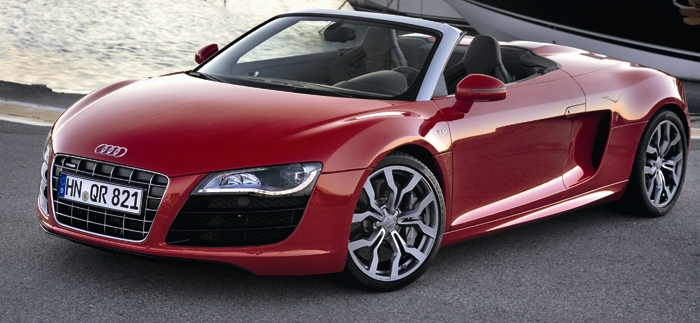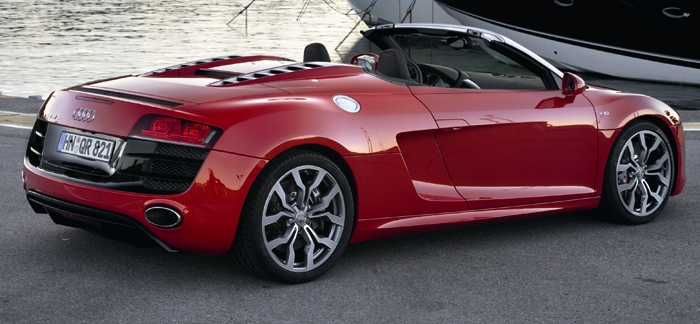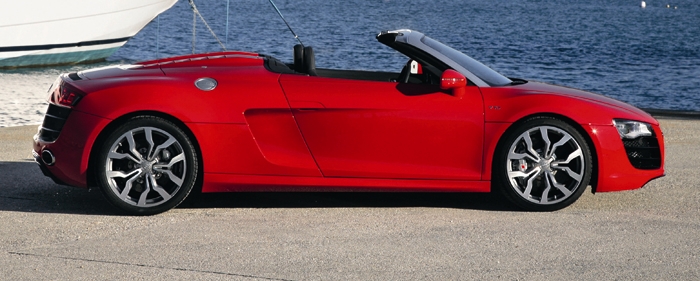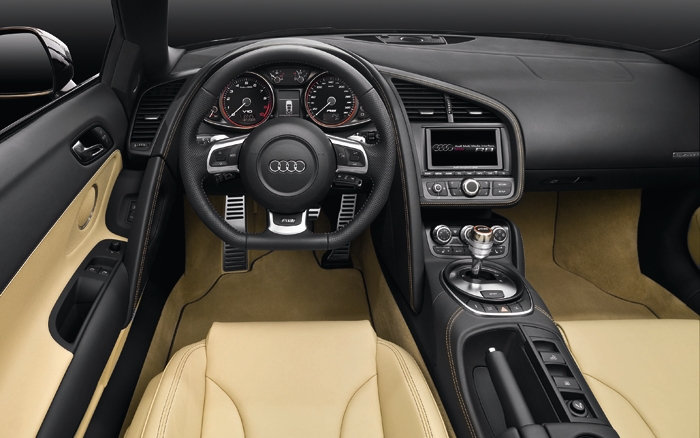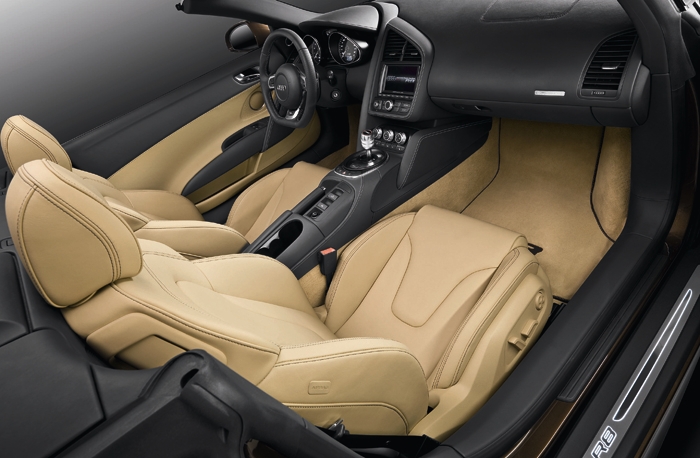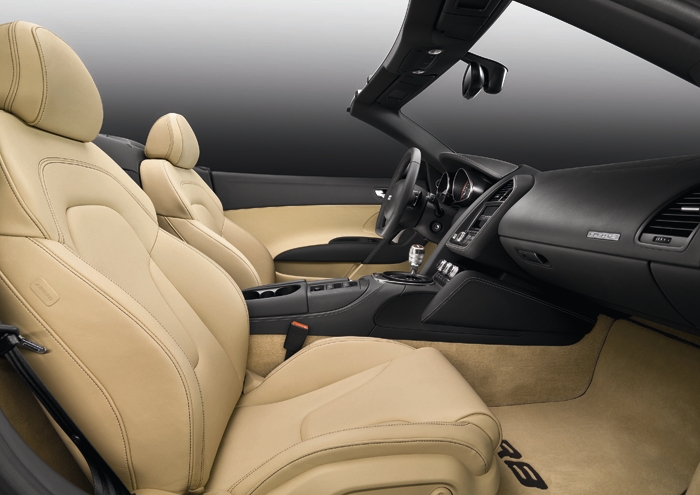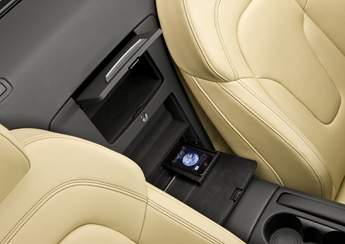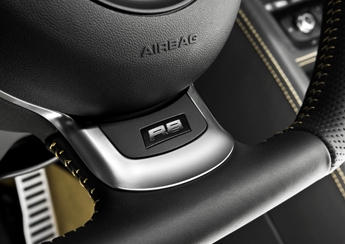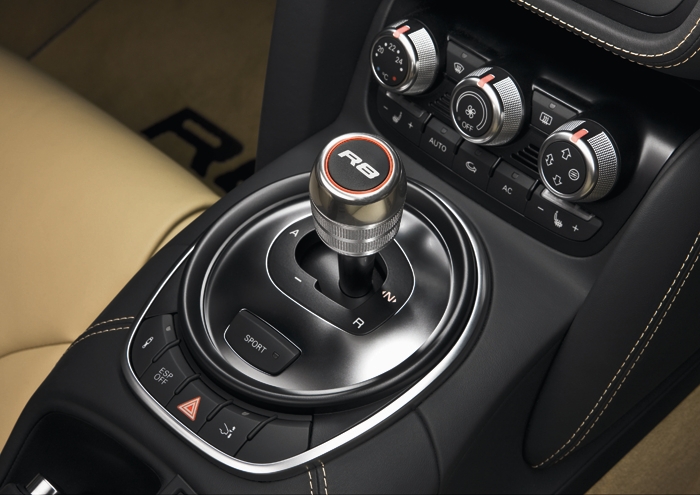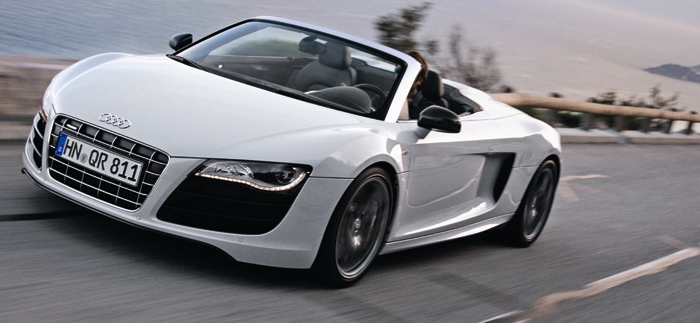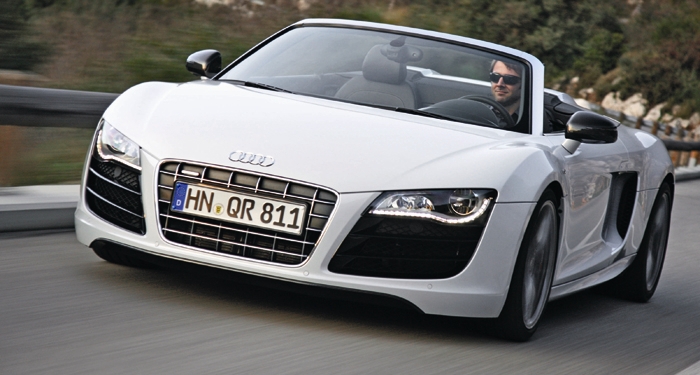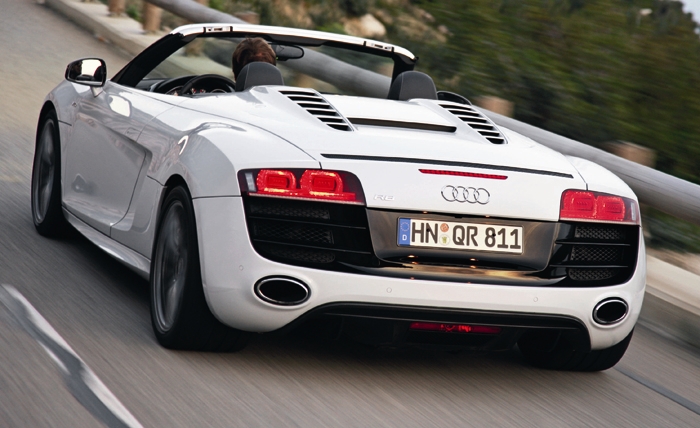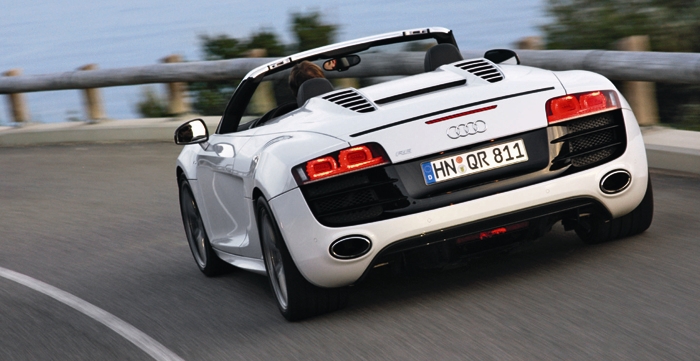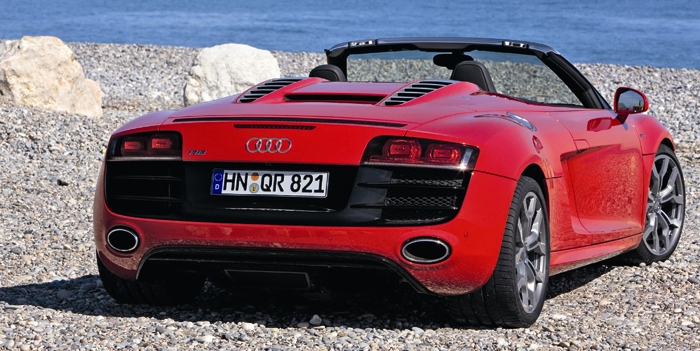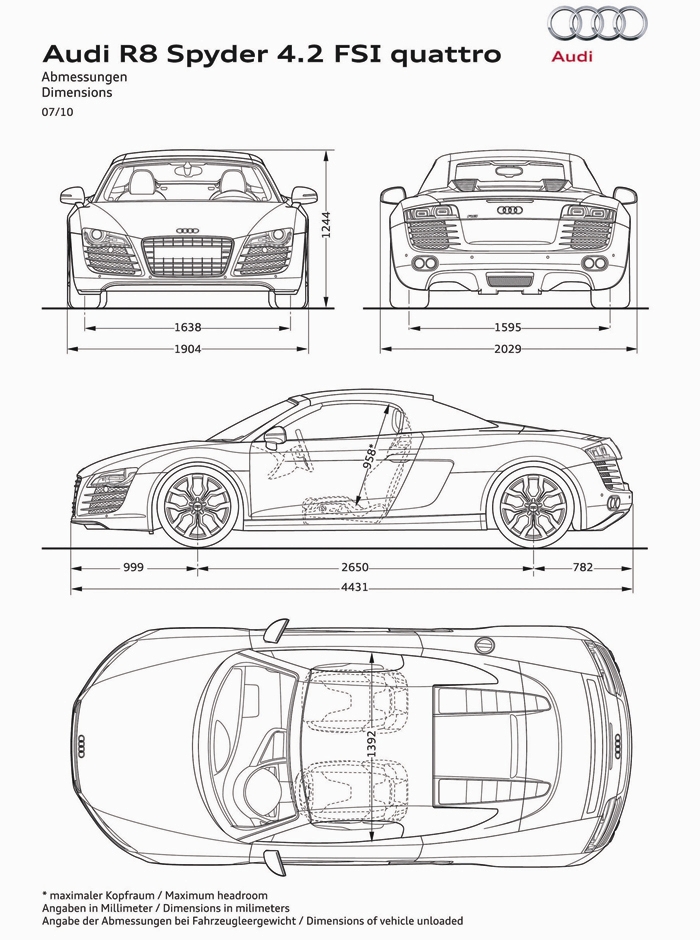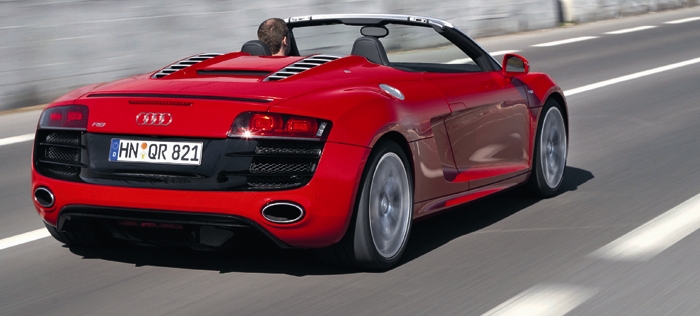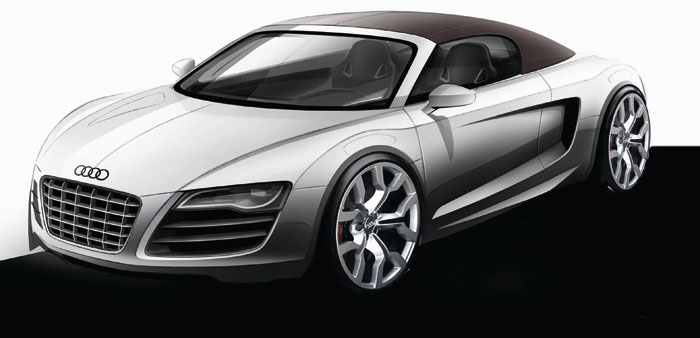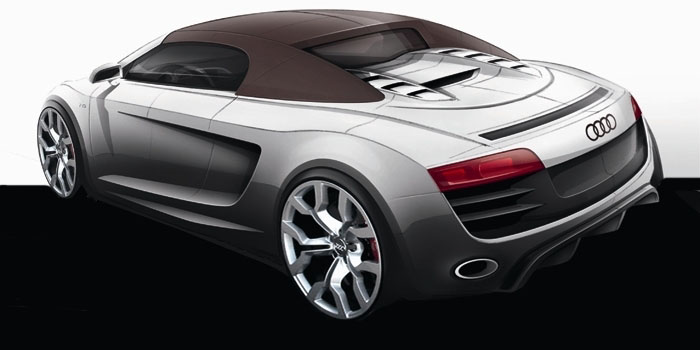|
|
|
|
The Audi R8 Spyder The R8 Spyder 5.2 FSI quattro features the V10 engine with 525 hp. It sprints from zero to 62.14 mph in 4.1 seconds and reaches a top speed of 194.49 mph. The open-two seater sets its own distinct accents. It does not include the storage space behind the seats and sideblades on the flanks. The rear side panels and the large cover over the compartment for the top are made of a carbon-fiber composite. Two cowls extending to the spoiler lip give the long back of the car a powerful profile. Typically Audi, the R8 Spyder 5.2 FSI quattro has a cloth top, which keeps the total weight and the vehicle's center of gravity low. It takes up little room when opened; when closed it integrates ideally into the design line. Its two slim fins draw a contour similar to that of the fixed roof of the coupé. With the standard hydraulic motor, the soft top opens and closes within 19 seconds, even while driving at speeds up to 31.07 mph. It is perfectly suitable for high-speed driving on the highway and is very quiet. The wind deflector is installed in just two steps. The glass window is integrated into the bulkhead separately and can be raised and lowered via a switch. The bulkhead also includes integrated rollover protection in the form of two strong, pretensioned plates. The Spyder's ASF body is reinforced in key area, yet weighs just 13.23 lb more than that of the coupé. 35/45 To reduce heating as a result of the sun's rays, the leather seats of the open two-seater are specially pigmented. Among the options is the seatbelt microphone for the hands-free unit, which makes it possible to talk on the phone with the top down on the highway. Integrated into the belts are three small microphones; a fourth is mounted on the windshield frame. The seat belt microphone is also available for the R8 Coupé. The engines: 4.2 V8 FSI quattro with 430 hp | 5.2 V10 FSI quattro with 525 hp
At a glance Convertible top and body
Engine
Drivetrain
Chassis
Equipment and trim
Full Details
- Pure Fascination Fascination taken to a new level of intensity: The Audi R8 Spyder 5.2 FSI quattro combines breathtaking performance with the experience of open-top driving. The 386 kW (525 hp) V10 engine accelerates the high-performance sports car with the lightweight cloth top to 100 km/h (62.14 mph) in 4.1 seconds on its way to a top speed of 313 km/h (194.49 mph). The R8 Spyder 5.2 FSI quattro features a fascinating package of technologies, including the Audi Space Frame (ASF) made of aluminum and carbon fiber composite, quattro permanent all-wheel drive, LED headlights and the innovative seatbelt microphone. The R8 Spyder 5.2 FSI quattro captivates from the very first glance. Its lines offer a unique interpretation of the dynamics and emotion of a high-performance sports car. Two distinctive silver cowls, into which the large air intake openings are integrated, give the long back a powerful profile. Unlike the Coupé, the R8 Spyder has classic air intakes behind the doors. The rear side panels and the large cover over the storage compartment for the cloth top are made of a carbon fiber composite. The R8 Spyder 5.2 FSI quattro sports a cloth soft top in classic Audi style. The soft top's approximate weight is a mere 42 kilograms (92.59 lb); it thus keeps the vehicle's total weight and center of gravity low. When closed it melds harmoniously into the design line – it ends in two slim fins that extend toward the rear and have a contour similar to that of the Coupé hard top. The top is suitable without restriction for high-speed driving and is quiet. With the standard electrohydraulic motor, the top opens and closes within 19 seconds, even while driving at speeds up to 50 km/h (31.07 mph). The heated glass window is integrated separately into the bulkhead and can be raised and lowered via a switch with the soft top up or down. Audi also provides a wind deflector that can be installed in just two steps. The bulkhead includes integrated rollover protection in the form of two pretensioned plates. The aluminum Audi Space Frame (ASF) body of the R8 Spyder is reinforced at important locations, yet it tips the scales at a mere 216 kilograms (476.20 lb) – just six kilograms (13.23 lb) more than the Coupé. Equipped with a manual transmission, the high-performance sports car weighs only 1,720 kilograms (3,791.95 lb).
The Audi R8 Spyder 5.2 FSI quattro is a sports car that is suitable for daily driving. The long 2.65-meter (8.69 ft) wheelbase and broad shoulder width of 1.39 meters (4.56 ft) allude to its generous spaciousness. Drivers and passengers of all sizes can find the idea seating position. Visibility is good, with narrow A-pillars ensuring a large diagonal view to the front. Another strength in daily use is the luggage compartment with room for 100 liters (3.53 cubic ft) under the hood. Mounted behind the seats is a three-bin storage box lighted with LEDs. One of the bins holds the optional CD changer or Audi Music Interface (AMI). The interior dazzles with a markedly sporty yet comfortable character and is heavily driver-oriented. Its most distinctive element is the monoposto – the large arc encompasses the steering wheel and the cockpit before ending in the driver door and the center tunnel. The monoposto characterizes the dynamic style of the interior every bit as much as the multifunction steering wheel with the ring flattened at the bottom. The controls are clearly structured, with the controls of the deluxe automatic air conditioners specially matched to the needs of open-top driving. Important information is displayed on a color monitor. The standard driver information system displays the speed digitally and includes a lap timer function for recording lap time. Red rings frame the instruments and the solid aluminum gear lever knob. The pedals, the footrests and the shift paddles of the R tronic are in aluminum look. The fit and finish of the R8 Spyder 5.2 FSI quattro is of unmatched quality – typical Audi. The surfaces of the instrument panel and door liners are backed with a soft material and the decorative stitching is extremely precise. Most of the interior is a sportily cool black; the decorative inlays shine with a satin finish and the aluminum applications adorn the door sill strips. Small LED lamps bath the interior in subtle light, if desired. Many of the components in the interior, such as the top sills and the instrument panel cover – are covered in leather. Numerous customization solutions are available. Audi offers Alcantara and leather upholstery in a wide variety of colors and grades, packages in carbon and black piano lacquer or a tailor-made set of suitcases. Elegant design and leather packages set additional individual accents. All inclusive: standard equipment The Audi R8 Spyder 5.2 FSI quattro will go on sale in Germany in the next few days with a long list of standard equipment at a base price of 156,400 euros. This includes power folding side mirrors, a light and rain sensor, LED headlights, an alarm system and a Bang & Olufsen sound system. It pumps out 465 watts and dazzles with excellent sound from 12 speakers. The systems mid-level bass and high frequency ranges have been specially matched to the acoustics in the R8 Spyder. Also included standard is the navigation plus system with MMI control logic featuring impressively high resolution and fast route calculation. It reads the route data from a DVD and presents it as a three dimensional graphic on the 6.5-inch monitor. The seats including the lumbar support are power adjustable and heated. Their Fine Nappa leather coverings are specially pigmented to reflect the infrared rays in sunlight and thus protect the interior from heating up. Audi offers a choice of the colors black, titanium gray, lunar silver, nougat brown, luxor beige and red. A worldwide first from Audi is the seatbelt microphone for the hands-free unit, which makes it possible to talk on the phone even with the top down on the highway. Integrated into each of the two belts are three microphones that resemble small, flat discs and do not interfere with the rolling up of the belts. When the seatbelt is being worn, one microphone is always located in the vicinity of the mouth, regardless of the person's height. Software analyzes the quality of the signals and forwards the best one to the hands-free unit. A fourth microphone is mounted on the windshield frame and is used to make calls when the car is parked and the seatbelt is not on. The range of optional equipment offers additional attractive features, including the Audi parking system advanced with integrated rearview camera, the high-beam assistant, a storage package or Bluetooth mobile phone preparation. A sports suspension with conventional dampers is available at no charge to sharpen the racing character. The front spoiler, the rear diffuser, the mirror housings and several engine compartment components are optionally available in carbon from Audi. quattro GmbH, which developed and builds the R8 Spyder 5.2 FSI quattro, will also fulfill more extravagant wishes.
The new top-of-the-range Audi offers incredible performance. The free-breathing V10 with the aluminum crankcase features direct gasoline injection. The 12.5:1 compression ratio that the FSI concept enables contributes to the high performance and good efficiency. Dry sump lubrication, another motorsport technology, ensures the reliable supply of oil even at the maximum lateral and longitudinal acceleration. The 5.2-liter engine produces 530 Nm (390.91 lb-ft) of torque at 6,500 rpm and 368 kW (525 hp) at 8,000 rpm. Its specific power output is 100.9 hp per liter of displacement; each hp only needs to move 3.3 kilograms (7.28 lb) of weight. The R8 Spyder 5.2 FSI quattro accelerates from zero to 100 km/h (62.14 mph) in 4.1 seconds on its way to a top speed of 313 km/h (194.49 mph). The engine offers amazing thrust and hangs tenaciously on the throttle in every situation accompanied by that unmistakable ten-cylinder Audi sound. Audi offers the R tronic sequential six-speed transmission as an option. This has a fully automatic and a manual mode, in which the driver can change gears in an instant using paddles on the steering wheel. Launch Control manages engagement of the clutch for maximum acceleration. The rear-biased quattro permanent all-wheel drive system transfers power to the road with supreme ease. Together with the locking differential on the rear axle, it provides significantly greater traction, stability, cornering speed and precision. Motorsport technology can also be found in the chassis of the Audi R8 Spyder 5.2 FSI quattro. There are double triangular wishbones made of aluminum at all four wheels, and the hydraulic rack-and-pinion power steering conveys highly-precise road feel. The standard suspension includes the high-end Audi magnetic ride technology, in which the shock absorbers adjust their response to the road conditions and the driver's style within milliseconds. A sports suspension with conventional shock absorbers is available as an option. The R8 Spyder 5.2 FSI quattro rolls on 19-inch wheels shod up front with 235/35 tires and 295/30 tires in the rear. The four brake discs are internally ventilated and perforated, and are gripped by a total of 24 calipers. Optionally available from Audi are large carbon fiber-ceramic discs that are lightweight, robust and long-lived. The ESP stabilization system has a Sport mode and can also be completely deactivated. Comfortable: interior, equipment and trim Equipment highlights include an excellent sound system from Bang & Olufsen, deluxe automatic air conditioning and heated seats. The leather seat coverings are specially pigmented to reduce heating as a result of the sun's rays. The standard navigation plus system with MMI control logic features impressively high resolution and fast route calculation. Also included standard in the Audi R8 Spyder 5.2 FSI quattro are the LED headlights – light-emitting diodes are used for the low beams, the high beams, the daytime running lights and the turn signals. The LED headlights not only look like technological works of art, they also offer substantial practical advantages with their excellent light distribution, long service life and extremely low energy consumption. Among the exclusive optional equipment available for the new R8 Spyder 5.2 FSI quattro is the innovative seatbelt microphone for the hands-free unit, which makes it possible to make telephone calls even with the top down on the highway. Integrated into each of the two belts are three small microphones; a fourth is mounted on the windshield frame
At only 215 millimeters (8.46 in) in diameter, the intermediate plate clutch in the R8 Spyder 5.2 FSI quattro is very compact, which is also necessitated by the low installation position of the engine. A six-speed manual transmission comes standard. The lever moves precisely and easily with short throws through a lavish, open stainless steel gate – typical Audi. Audi also offers the R8 Spyder with an optional high-tech transmission – the sequential R tronic. With the short selector lever and the aluminum-look paddles on the steering wheel, it conveys an authentic racing feeling. Shift speeds vary as needed: The change of gears is comfortable during moderate driving; at higher engine loads and speeds, gear changes are completed within a tenth of a second. The driver's commands are transmitted electrically. The gearshift unit has its own hydraulic fluid loop, which is pressurized to between 40 to 50 bar. The hydraulics manage the clutch and change the gears. The R tronic is a versatile system, offering both a manual and a fully automatic operating mode. In both cases the driver can choose from two programs. The R tronic is most comfortable in the "Automatic Normal" mode, and offers the greatest dynamics in "Manual Sport" mode. The standard launch control feature permits rocket-like starts. It is activated by a simple and exciting procedure: Select S mode, turn off the ASR anti-slip control, put the car in gear, step on the brake, floor the accelerator and wait until a constant engine speed is established. When the driver then releases the brakes, the launch control manages the engagement of the clutch within milliseconds, and the V10 delivers all of its power to the road with ideal tire slip. The Audi R8 is the only vehicle for which Audi offers this function with a manual transmission. More grip: quattro permanent all-wheel drive The mid-engine concept of the R8 model series necessitates a special layout for the quattro drivetrain. One drive shaft runs from the gearbox, which is mounted transversely behind the V10, through the engine to the front differential, where a viscous coupling distributes the power between the axles. In regular operation, it sends roughly 85 percent of the torque to the rear axle and can send up to 30 percent to the front within milliseconds, if necessary. A mechanical locking differential at the rear axle further improves traction. It provides a locking value of up to 25 percent when accelerating and up to 40 percent on the overrun.
The mid-engine concept is the ideal solution for the Audi R8 Spyder 5.2 FSI quattro high-performance sports car. It enables an axle load distribution ratio of 43:57 between the front and back, and packs the engine in the middle of the car, close to the vertical axis. This nearly eliminates the inertia of the engine mass during fast changes of direction. The fuel tank is located close to the engine, in the crash-protected area behind the seats. The amount of fuel has hardly any effect on axle load distribution. The R8 Spyder 5.2 FSI quattro is an integrated system of speed and highly concentrated emotions embedded in perfect technical expertise. The high-performance sports car from Audi turns spontaneously, almost immediately, into corners and handles them with stoic aplomb, precisely guided by its responsive steering. The limit is extremely high and is very easy to manage, and all four wheels claw back into the asphalt at an early stage when exiting the curve. The quattro all-wheel drive literally meshes the car with the road. Yet the chassis is surprisingly comfortable over long distances. The double triangular wishbones at all four wheels – a classic principle in motorsport – are forged aluminum to reduce the unsprung masses. Rubber-metal bearings dissipate lateral forces into the body with carefully defined precision, while at the same time ensuring good longitudinal elasticity and filtering a majority of the undesired vibrations away from the road. The track measures 1.64 meters (5.38 ft) up front and 1.60 meters (5.25 ft) in the back. The hydraulic rack-and-pinion power steering with its highly differentiated, sensitive feedback makes a major contribution to the feeling of uncompromising precision when driving the vehicle. It features a sporty and direct 16.3:1 ratio. Audi fine-tuned the chassis and its setup over 9,000 test kilometers in the toughest laboratory in the world – the North Loop of the Nürburgring race track. Sophisticated damping: Audi magnetic ride The R8 Spyder 5.2 FSI quattro comes standard with another high-end feature – Audi magnetic ride continuously adapts the function of the chassis to the profile of the road and the driver's style. The controller, which receives signals from a sophisticated system of sensors, continuously computes the optimal values for each individual wheel. When the R8 Spyder steers into a curve, the damping force on the outermost wheel is increased, which reduces the tendency of the body to roll and the reaction becomes even more spontaneous. The driver can choose between two base characteristics – normal mode and sport mode. A synthetic hydrocarbon oil containing tiny magnetic particles between 3 and 10 thousandths of a millimeter in diameter – one tenth the thickness of a human hair – circulates in the shock absorber pistons. When a current is applied to a coil, a magnetic field is generated in which the particles realign so as to be perpendicular to the flow of the oil in the piston channels and thus prevent it from flowing through. This process is completed in just a few milliseconds, much faster than with conventional adaptive damping. The R8 Spyder 5.2 FSI quattro rolls on 19-inch, forged alloy wheels with an attractive 10-spoke Y design. The tires measure 235/35 up front and 295/30 in the back, and a control function monitors the tire pressure. The Audi exclusive line includes wheels of the same size featuring a five-twin-spoke design and a titanium gray or high-gloss, polished surface. Incredible performance: the brakes To dissipate the heat as quickly as possible, the discs are internally ventilated and perforated. The discs measure 365 millimeters (14.37 in) in diameter at the front and 356 millimeters (14.02 in) at the rear. Each disk comprises a steel friction ring and an aluminum cap; the two components are connected by stainless steel pins to prevent the transfer of temperature peaks. Audi will mount an exclusive technology upon request – perforated ceramic brake discs painted Anthracite Gray. On duty up front are six-piston monoblock calipers of aluminum and 380 millimeter (14.96 in) discs, with floating calipers and 356 millimeter (14.02 in) discs in the back. The calipers are painted Anthracite Gray and are bear the lettering "Audi Ceramic." The ceramic disks are extremely lightweight, together weighing nine kilograms (19.84 lb) less than their steel counterparts. They can also easily handle the loads of more aggressive driving and are always free of corrosion. The base material for the ceramic discs is silicon carbide, an extremely hard, abrasion-resistant material with a diamond-like crystal structure. Embedded in it are high-strength carbon fibers that absorb stresses. The complex geometry of the cooling ducts ensures that heat is rapidly dissipated. The friction ring is bolted to the stainless steel cap via ten elastic elements. The Audi R8 Spyder 5.2 FSI quattro brakes with aplomb – strongly, precisely and stably. A specially configured stabilization system monitors the vehicles dynamic driving limits. At the touch of a button, the driver can activate a sport mode that permits spectacular but safe oversteer when the gas is applied while exiting a curve. The ESP together with the anti-slip control can also be completely deactivated for dynamic driving situations such as a trip to the race track. The hill-start assist, a sub-function of the system, makes it easier to start off on grades by maintaining the brake pressure for a brief period after the brake pedal is released.
The top of the R8 Spyder 5.2 FSI quattro is made of cloth – an Audi classic and an uncompromising solution for a high-performance sports car. The soft top's approximate weight is a mere 42 kilograms (92.59 lb); it thus keeps the vehicle's total weight and center of gravity low. When closed it melds perfectly into the design line – it ends in two elegant, narrow fins that extend toward the rear and have a contour similar to that of the Coupé hard top. The fins make it possible to pull the material back tightly. The top comprises an outer skin of a leakproof textile fabric. A headliner covers the frame, large portions of which are made of die-cast magnesium and aluminum. The soft top is entirely suitable for high-speed driving and acoustically very comfortable. When driving at 130 km/h (80.78 mph) with the top up, the wind noise level in the R8 Spyder are barely higher than in the Coupé, and at high speeds it is lower than in any of the competitor's cars. The soft top has a straight electrohydraulic motor that is quieter and lighter than the electrohydraulics typically used. The pump mounted on the underbody of the R8 Spyder operates with a pressure of 120 bar. A system of actuating cylinders, hinges and hooks opens and closes the top in 19 seconds, even while driving at speeds up to 50 km/h (31.07 mph). The procedure is initiated either by the key in the door lock or by the switch on the center tunnel. For reasons of safety, the button must be held when the vehicle is at rest, but a brief push of the button is all it takes to open the top at speeds of 6 km/h (3.73 mph) or above. When opening the top, the windows first slide down, then the fins of the soft top turn upward. The large cover of the storage compartment, secured to two seven-link hinges, moves upward and in a curve to the rear. The soft top folds together in the shape of a Z and comes to rest as a three-layer, flat package in its compartment above the V10 engine. Finally, the cover closes again, first up front and then in the back. The heated glass rear window, which is separate from the cloth top, is lowered into the bulkhead behind the seats. It can be raised and lowered via a separate switch, independent of the position of the top. When the soft top is open, it only rises 15 centimeters (5.91 in) – ideal for damping turbulence. It can also be nice to lower the window when the top is closed. When the sun is hot, lowering the window improves interior ventilation without causing unpleasant drafts. A bag in the luggage compartment of the R8 Spyder contains a wind deflector with a solid frame. It can be snapped into its mountings on the bulkhead in just two steps. The wind deflector keeps the interior nearly free of drafts at speeds of up to around 200 km/h (124.27 mph). Total safety: rollover protection Head/thorax side bags in the backrests protect the passengers in the event of a side impact. Full-size airbags stand at the ready in the event of a head-on collision. In a rear-end collision, the integral Audi head restraint system reduces the risk of whiplash injuries. The top with its drive system, the storage compartment, the cover and the rollover protection system forms a premounted assembly. It is installed in the vehicle during its craft-scale manufacture at Audi's Neckarsulm site, where the R8 Spyder is built. The module gives the ASF body additional rigidity, thus contributing to the dynamic handling, the greater passive safety and the supreme vibrational comfort on board. Ultra lightweight: the ASF body The aluminum body of the R8 Spyder is top in its segment when it comes to lightweight quality – the relationship between weight, size and torsional rigidity. The body in white is comprised of three wrought components: Extruded aluminum sections comprise 75 percent; vacuum-cast nodes 8 percent; and the aluminum panels that are integrated into this skeleton with friction connections make up 17 percent. The panels are made of alloys that cure under heat - they attain their final hardness during the painting process, which includes drying in the oven. Audi drew on its comprehensive expertise for the construction of the body. The ASF structure integrates a semi-supporting engine frame made of ultra lightweight magnesium. The floor tunnel is reinforced with custom, particularly lightweight tailored blanks. The thickness of the individual panels varies as needed. They are joined by means of friction stir welding – a new method characterized by outstanding tightness, high dimensional accuracy and minimal distortion. The body of the Spyder shares roughly 70 percent of its parts with the body of the Coupé. Critical areas – such as the center tunnel and the bulkhead – have been specially reinforced to be more rigid. The A and B-pillars and the sills have thicker sections; a crossbeam and aluminum plates that act as thrust plates are integrated into the central region of the floor. An aluminum panel is also attached to its underside, which further improves lateral rigidity. Additional sections in the doors serve as load paths in the event of a frontal collision. Despite all of these reinforcements, the body tips the scales at a mere 216 kilograms (476.20 lb), just six kilograms (13.23 lb) more than the Coupé. Equipped with a manual transmission, the R8 Spyder 5.2 FSI quattro weighs only 1,720 kilograms (3,791.95 lb) and just five kilograms (11.02 lb) more in the R tronic version. The side panels and the large cover of the top storage compartment also contribute to this positive value. They are made of carbon fiber composite produced using a new method. In addition to being faster and more energy-efficient than conventional production in an autoclave, resin transfer molding (RTM) also yields superior surface quality. Fiber-reinforced plastic is used for the engine compartment cover and the rear spoiler; thermoplastics are used for the bumpers. Much of the body is lovingly built by hand at the Neckarsulm plant. The front end, the central floor and the rear end are assembled separately from one another. After they are joined to form the substructure, the pillars and the large metal panels – primarily the roof, the side walls, the doors and the cover panels – are added. Highly qualified employees make the weld seams, which total 107 meters (351.05 ft) in length. 814 self-piercing rivets and 188 automatically placed, self-tapping screws join the structural panels with the ASF skeleton. The work is characterized by the utmost precision. A fully-automatic measuring system checks the dimensional accuracy of each body down to a tenth of a millimeter. The scanner works without contact and uses its 95 laser sensors to check 220 points within five seconds. The computer tomograph in which Audi performs random checks measures even more precisely. Its x-rays can detect deviations on the thousandths of a meter scale.
|
|
|
|
|
